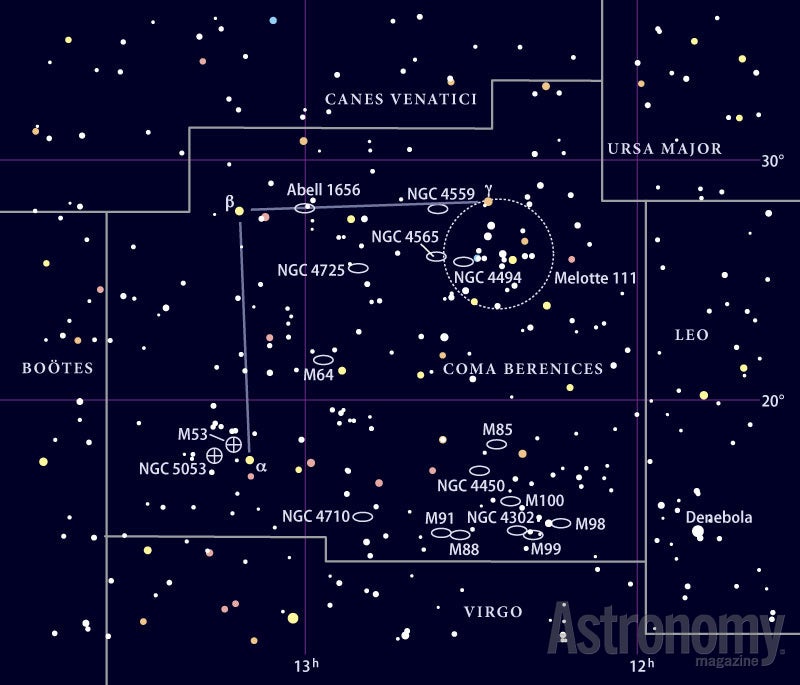Targets for March 19–26, 2015
Small telescope: Elliptical galaxies M84 and M86
Small telescope: Spiral galaxy M98
Large telescope:The Eyes (NGC 4435 and NGC 4438)
This week’s first small-telescope target is a pair of elliptical galaxies in Virgo the Maiden, M84 and M86. French comet-hunter Charles Messier discovered them March 18, 1781 — only five days after German-born British astronomer Sir William Herschel found Uranus.
It’s easy to confuse M84 with nearby M86. Only 17′ separate the two. Both lie midway between magnitude 2.1 Denebola (Beta [β] Leonis) and magnitude 2.9 Vindemiatrix (Epsilon [ε] Virginis). They shine with nearly equivalent brightnesses.
M84 glows at magnitude 9.1 and M86 at magnitude 8.9, so from a dark observing site, even a 4-inch scope will have no trouble revealing them.
M84, however, lies a bit more westerly. Also, under high magnifications M84 appears smaller, and that’s when you’ll perceive that it’s slightly fainter than its neighbor. M84 spans 5.1′ by 4.1′.
M86 proves that not all elliptical galaxies are circular. In fact, this bright object appears oval even at low magnifications. It measures 12.0′ by 9.3′.
Modern galaxy classification schemes lean toward M86 as a lenticular (lens-shaped) galaxy, rather than a strict elliptical. Crank up the power and you’ll reveal M86’s starlike core.
Spiral splendor
This week’s second small-scope object is another entry in Messier’s famous catalog — spiral galaxy M98 in Coma Berenices. It glows at magnitude 10.1 and measures 9.1′ by 2.1′.
No bright stars lie in the area, so to locate this fine target, point your telescope 7.2° east of magnitude 2.1 Denebola (Beta [β] Leonis).
Under a dark sky, through a 4-inch telescope at a magnification of 200x, you’ll see a fat spindle four times as long as it is wide oriented north-northwest to south-southeast. The central region is broad and slightly brighter than the arms. Step up to a 16-inch scope and attach a nebula filter to your eyepiece, and you’ll see knots in the spiral arms marking the positions of large star-forming regions.
Cosmic struggle
This week’s large-telescope target is the Eyes — so-called because of their appearance through medium-sized telescopes.
Observers also know them as spiral galaxies NGC 4435 and NGC 4438 in Virgo. The first glows at magnitude 10.8 and measures 3.2′ by 2.2′. The latter shines at magnitude 10.2 and measures 2.7′ by 1.5′.
Astronomers sometimes refer to this pair as Markarian’s Eyes, in honor of Armenian astronomer Beniamin Markarian, who died in 1985.
This duo lies 0.4° east of M86. Because of immense gravitational forces, the Eyes are tearing themselves apart. Astronomers estimate the two passed within 16,000 light-years of each other some time in the past. NGC 4438 is the more distorted galaxy. Try to spot this object’s irregular outer regions.
Expand your observing at Astronomy.com
StarDome
Check out Astronomy.com’s interactive StarDome to see an accurate map of your sky. This tool will help you locate this week’s targets.
The Sky this Week
Get a daily digest of celestial events coming soon to a sky near you.
Observing Talk
After you listen to the podcast and try to find the objects, be sure to share your observing experience with us by leaving a comment at the blog or in the Reader Forums.











